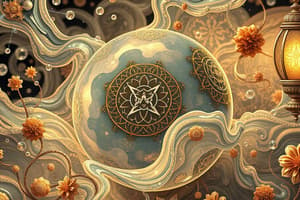Podcast
Questions and Answers
Describe the difference between an extensive property and an intensive property and give an example of each.
Describe the difference between an extensive property and an intensive property and give an example of each.
An extensive property depends on the amount of matter, such as mass and volume. An intensive property depends on the type of matter, such as color and hardness.
List three physical properties of copper.
List three physical properties of copper.
Reddish-yellow color, conductor of heat and electricity, malleable.
Name two physical properties that could be used to distinguish between water and ethanol.
Name two physical properties that could be used to distinguish between water and ethanol.
Melting point and boiling point.
Name one physical property that could not be used to distinguish chlorine from oxygen.
Name one physical property that could not be used to distinguish chlorine from oxygen.
What is the physical state of each of these materials at room temperature? a. gold b. gasoline c. neon d. olive oil e. oxygen f. mercury
What is the physical state of each of these materials at room temperature? a. gold b. gasoline c. neon d. olive oil e. oxygen f. mercury
Compare the arrangements of individual particles in the three states of matter.
Compare the arrangements of individual particles in the three states of matter.
What is the difference between homogeneous mixtures and heterogeneous mixtures?
What is the difference between homogeneous mixtures and heterogeneous mixtures?
How many phases does a solution have? Explain your answer.
How many phases does a solution have? Explain your answer.
Classify each of the following as homogeneous or heterogeneous mixtures: a. chocolate-chip ice cream b. green ink c. cake batter d. cooking oil
Classify each of the following as homogeneous or heterogeneous mixtures: a. chocolate-chip ice cream b. green ink c. cake batter d. cooking oil
What is the goal of distillation? Describe briefly how this goal is accomplished.
What is the goal of distillation? Describe briefly how this goal is accomplished.
How could you distinguish an element from a compound?
How could you distinguish an element from a compound?
Name the elements found in each of the following compounds: a. ammonia (NH3) b. potassium oxide (K2O) c. sucrose (C12H22O11) d. calcium sulfide (CaS)
Name the elements found in each of the following compounds: a. ammonia (NH3) b. potassium oxide (K2O) c. sucrose (C12H22O11) d. calcium sulfide (CaS)
What does the formula H2O tell you about the composition of water?
What does the formula H2O tell you about the composition of water?
Classify each of the following as a physical or chemical change. For any chemical change, list at least one clue to support your answer: a. A copper wire is bent b. Charcoal burns in a grill c. Bread dough rises when yeast is added d. Sugar dissolves in water.
Classify each of the following as a physical or chemical change. For any chemical change, list at least one clue to support your answer: a. A copper wire is bent b. Charcoal burns in a grill c. Bread dough rises when yeast is added d. Sugar dissolves in water.
Flashcards are hidden until you start studying
Study Notes
Properties of Matter
- Extensive properties depend on the amount of matter; examples include mass and volume.
- Intensive properties depend on the type of matter; examples include color and hardness.
Physical Properties of Copper
- Reddish-yellow color
- Good conductor of heat and electricity
- Malleable
- Melting point: 1084°C
- Boiling point: 2562°C
Distinguishing Liquids
- Melting point and boiling point can differentiate between water and ethanol.
Gas Comparison
- Chlorine and oxygen cannot be distinguished by state, as both are gases.
Physical States at Room Temperature
- Gold: solid
- Gasoline: liquid
- Neon: gas
- Olive oil: liquid
- Oxygen: gas
- Mercury: liquid
Particle Arrangements in States of Matter
- Solids: particles are tightly packed in an orderly arrangement.
- Liquids: particles are close but not orderly.
- Gases: particles are relatively far apart.
Mixture Classifications
- Homogeneous mixtures have a uniform composition, while heterogeneous mixtures have a non-uniform composition with two or more phases.
- Solutions are classified as homogeneous, containing one phase.
Example Mixtures
- Chocolate-chip ice cream: heterogeneous
- Green ink: homogeneous
- Cake batter: can vary (depends on mixing)
- Cooking oil: homogeneous
Distillation Process
- The goal of distillation is to separate components of a solution.
- Accomplished by boiling the solution to produce vapor, then condensing that vapor back into liquid, leaving dissolved solids behind.
Distinguishing Elements from Compounds
- Elements cannot be separated by chemical means, while compounds can.
Elements in Compounds
- Ammonia (NH3): nitrogen, hydrogen
- Potassium oxide (K2O): potassium, oxygen
- Sucrose (C12H22O11): carbon, hydrogen, oxygen
- Calcium sulfide (CaS): calcium, sulfur
Water Composition
- The formula H2O indicates water contains two parts hydrogen for every one part oxygen.
Physical vs Chemical Changes
- Physical change: bending a copper wire (no new substance formed).
- Chemical change: burning charcoal (color change indicates reaction).
- Chemical change: bread dough rising (production of gas due to yeast).
- Physical change: dissolving sugar in water (no new substance formed).
Studying That Suits You
Use AI to generate personalized quizzes and flashcards to suit your learning preferences.



